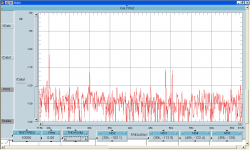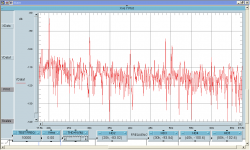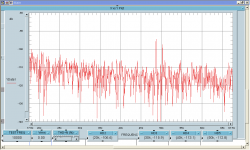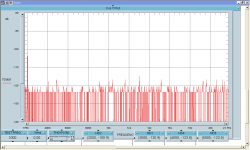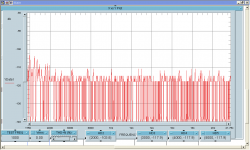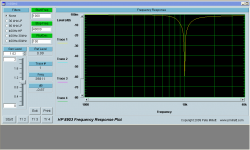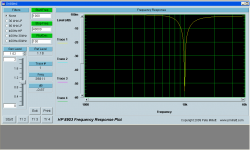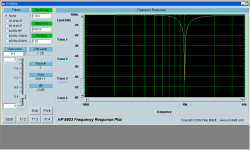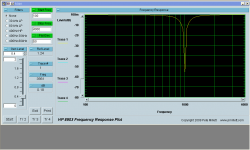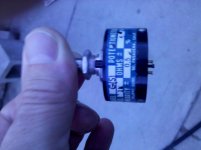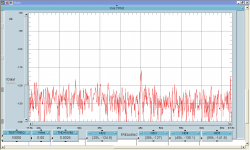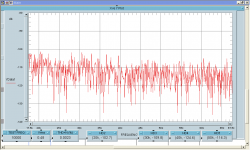@Ken -- it's hard to see the spectra with your photos, in part due to limited pixels, but also because of the frequency span. Can you make the span less than 100kHz when looking at lower frequency fundamentals? And can you normalize the amplitude to 10dB/div for better clarity?
@AndrewT -- the Cordell DM does not work with oscillators because in action, it simply sums/nulls the input to the device under test (DUT) with the output of the DUT, and displays what's left over. This is great because it doesn't much matter about exactly how low the distortion of the source is, what you see is only what's added by the DUT -- you can even use music for a test signal once you get eveything nulled out with test signals. But with an oscillator, there's no "input" signal to do the summing of the output with. The Active Twin-T filter just nulls out the fundamental a lot -- say 60dB or more -- without adding any significant distortion of its own, and without attenuating any of the harmonics of the oscillator or other device under test, so that whatever spectrum analyzer you use can have it's best dynamic range for looking at the residuals.
Ken's explanation of what the Twin-T does is good -- for more detail than you probably want, see my webpage on this filter:
Active Twin-T filter
@AndrewT -- the Cordell DM does not work with oscillators because in action, it simply sums/nulls the input to the device under test (DUT) with the output of the DUT, and displays what's left over. This is great because it doesn't much matter about exactly how low the distortion of the source is, what you see is only what's added by the DUT -- you can even use music for a test signal once you get eveything nulled out with test signals. But with an oscillator, there's no "input" signal to do the summing of the output with. The Active Twin-T filter just nulls out the fundamental a lot -- say 60dB or more -- without adding any significant distortion of its own, and without attenuating any of the harmonics of the oscillator or other device under test, so that whatever spectrum analyzer you use can have it's best dynamic range for looking at the residuals.
Ken's explanation of what the Twin-T does is good -- for more detail than you probably want, see my webpage on this filter:
Active Twin-T filter
Dick,
Attached are the following:
Image:
1. 10kHz 0.5v 0db
2. 10kHz 0.5v +20db (for those following along, subtract 20db from the harmonic values to get the true value)
3. 10kHz 0.1v +20db
1k to follow in next post
Ken
Attached are the following:
Image:
1. 10kHz 0.5v 0db
2. 10kHz 0.5v +20db (for those following along, subtract 20db from the harmonic values to get the true value)
3. 10kHz 0.1v +20db
1k to follow in next post
Ken
Attachments
Part two:
( I forgot to mention I cooked up this program in agilent VEE to drive the signal analyzer and the 8903A, the vrms and thd display boxes are not turned on, as the cable is not connected currently to 8903A input)
Image:
1. 1kHz 0.5v 0db (couldn't get quite as deep of a null in the middle setting range -40 db so the -20db is worth showing)
2. 1kHz 0.1v +20db
Ken
( I forgot to mention I cooked up this program in agilent VEE to drive the signal analyzer and the 8903A, the vrms and thd display boxes are not turned on, as the cable is not connected currently to 8903A input)
Image:
1. 1kHz 0.5v 0db (couldn't get quite as deep of a null in the middle setting range -40 db so the -20db is worth showing)
2. 1kHz 0.1v +20db
Ken
Attachments
Ken, what is the maximum output of the 8903 at 1kHz? 3.16VRMS into 600 ohms -- 6.3VRMS into hi-Z (like the Twin-T)? I was wondering why you are using such low output voltages?
Dick,
Max output looks like 6vrms. I am used to testing power amps, so, I run in the .1v to 1v range. I'll give it a go at higher power and see if it changes the THD.
Ken
Hi Dick,
I ran a frequency response plot (thanks to PMillett) of the Twin-T. Input voltage 1v, Twin - T tuned to 10kHz about -60db null. You can see that it's a bit lopsided. The value at 1kHz is 0db, at 20kHz it's -1.42, at 30kHz it's -0.98db. I ordered some 1% caps today and will see if that helps.
What do you think?
Ken
I ran a frequency response plot (thanks to PMillett) of the Twin-T. Input voltage 1v, Twin - T tuned to 10kHz about -60db null. You can see that it's a bit lopsided. The value at 1kHz is 0db, at 20kHz it's -1.42, at 30kHz it's -0.98db. I ordered some 1% caps today and will see if that helps.
What do you think?
Ken
Attachments
I think you should repeat this trial with a 1kHz fundamental, just to eliminate any possible bandwidth issues with the active amp in the filter, then check the actual upper bandwidth (-1dB) point of the filter.
I also think that it looks like the filter is being driven from a 600 ohm source, which will tend to cause the lopsided response -- 600 ohms is about the upper limit on source Z for decent measurements. Try driving from a lower impedance source, like the output of a power amp -- just for response checking. Then for distortion readings, you can always re-normalize your "0dB" to the upper passband level resulting from the source Z that you're using, without causing problems, because the products you're measuring are all in the upper pass band of the filter. It is always good to have bandwidth/level plots for the actual measuring conditions that you are working in.
I also think that it looks like the filter is being driven from a 600 ohm source, which will tend to cause the lopsided response -- 600 ohms is about the upper limit on source Z for decent measurements. Try driving from a lower impedance source, like the output of a power amp -- just for response checking. Then for distortion readings, you can always re-normalize your "0dB" to the upper passband level resulting from the source Z that you're using, without causing problems, because the products you're measuring are all in the upper pass band of the filter. It is always good to have bandwidth/level plots for the actual measuring conditions that you are working in.
I think you should repeat this trial with a 1kHz fundamental, just to eliminate any possible bandwidth issues with the active amp in the filter, then check the actual upper bandwidth (-1dB) point of the filter.
.
Hi Dick,
How do I check the upper bandwidth (-1db) point of the filter?
I ran the 10k and 1k plots through my power amplifier. The 10k improved a bit to -.97db at 20k and -.60 at 30k. Then ran 1k again through the amp and got -.09db at 2k and +.12db at 3k. So, it seem more like a bandwidth thing. Also seems to answer the question about whether the Q is too high (probably not). I can't get as deep of a notch on the 1k setting as I can on the 10k setting. I'm thinking that this is a result of the capacitors not matching as well. I ordered 1% caps and will re-fit those along with moving the trimmers to be adjustable without opening the box.
Found some nice surplus precision 1k pots for 50c each for the trimmers.
Ken
Dick,
Unpacked the Krohn-Hite 4402B today. It's main output is 50ohm along with a 7 Vrms fixed 600 ohm output as well. I presume that the best way to test this is through a power amp? I can also put it through my preamp which is based upon the LME49713. Which would be better?
Ken
Unpacked the Krohn-Hite 4402B today. It's main output is 50ohm along with a 7 Vrms fixed 600 ohm output as well. I presume that the best way to test this is through a power amp? I can also put it through my preamp which is based upon the LME49713. Which would be better?
Ken
Dick,
Unpacked the Krohn-Hite 4402B today. It's main output is 50ohm along with a 7 Vrms fixed 600 ohm output as well. I presume that the best way to test this is through a power amp? I can also put it through my preamp which is based upon the LME49713. Which would be better?
Ken
Now I'm starting to answer my own questions by re-reading your prior posts... " I also think that it looks like the filter is being driven from a 600 ohm source, which will tend to cause the lopsided response -- 600 ohms is about the upper limit on source Z for decent measurements. Try driving from a lower impedance source, like the output of a power amp -- just for response checking." So, the Krohn-Hite has 50 ohm output - a lower source Z than 600 ohm - so, it should be good to go without running it through an amp.
Ken
Hi Ken -- just got back from a little fall trip to Mt. Baker. If you're basing your assessment of the notch depth by sweeping the filter using a sweep from the 8903, this will not show the true depth of the notch -- the sweep frequency resolution just isn't fine enough -- we're talking milli- and micro-Hertz here. Use a fixed frequency source and manually tune the filter while looking at the filter output on the spectrum analyzer's display.
To check the filter's HF roll-off, just put the filter in bypass mode and check the response as you normally would for any amplifier -- it's entirely a function of the filter amplifier's response -- the Twin-T has no effect on the upper bandwidth limit (at least as long as the source Z is fairly low).
Nice pots!
The 4402B has a max output of approximately 7VRMS behind 50 ohms at the main output, and behind 600 ohms at the other outputs. I'm not sure what it's max output is when actually loaded with 50 ohms, but the specs probably say. Running directly into the filter is AOK from the main output -- no amp needed.
To check the filter's HF roll-off, just put the filter in bypass mode and check the response as you normally would for any amplifier -- it's entirely a function of the filter amplifier's response -- the Twin-T has no effect on the upper bandwidth limit (at least as long as the source Z is fairly low).
Nice pots!
The 4402B has a max output of approximately 7VRMS behind 50 ohms at the main output, and behind 600 ohms at the other outputs. I'm not sure what it's max output is when actually loaded with 50 ohms, but the specs probably say. Running directly into the filter is AOK from the main output -- no amp needed.
Last edited:
Hi Ken -- just re-read the posts -- if your approx. -1dB at the 2nd H is correct, then you don't have too much feedback; it would be good to know those figures for a 1kHz fundamental, since I've never actually checked the harmonic attenuation at high frequencies.
I selected my caps to within about 0.5% matching, so I expect that closer matching will help your tuning, both within and across ranges.
I selected my caps to within about 0.5% matching, so I expect that closer matching will help your tuning, both within and across ranges.
Hi Ken -- just re-read the posts -- if your approx. -1dB at the 2nd H is correct, then you don't have too much feedback; it would be good to know those figures for a 1kHz fundamental, since I've never actually checked the harmonic attenuation at high frequencies.
Hi Dick,
Have a look at Post #30, the second plot is the 1kHz fundamental. It's at -0.19dB at 2nd H. So, better than the 10kHz. Still, the 10kHz is good enough for me.
I fired up the 4402B this morning (couldn't resist). Set at 10kHz, with it's volume pot set at 2Vrms, the fundamentals we're so good, turned the volume down to 0.6Vrms and the fundamentals went very quiet. Re-calibrated the spectrum analyzer and got 2h -113dB, 3h -123dB 4 & 5h down in the noise. Turned on the +20dB switch and got 2h -92dB, 3h -103dB 4 & 5h -123db.
The 8903a reported THD+N at .0022%, probably more noise than THD. I didn't have a thumb drive handy, but will retest and post images.
Ken
Hi Dick,
I remembered that JackinNJ had posted a comparison of the 4400 and the AP1. I found the post: http://www.diyaudio.com/forums/equipment-tools/160432-diy-analog-digital-converter-project-audio-measurements-tool-5.html#post2135534 It's #41. Looks like the 4402 is a shade better.
Ken
I remembered that JackinNJ had posted a comparison of the 4400 and the AP1. I found the post: http://www.diyaudio.com/forums/equipment-tools/160432-diy-analog-digital-converter-project-audio-measurements-tool-5.html#post2135534 It's #41. Looks like the 4402 is a shade better.
Ken
So, the 10kHz harmonic products sum to something under 0.0003% or 3ppm -- that's very good. I suspect that the notch filter fine tuning of the 8903A may be a little off -- there are a couple of pots that fine tune it. Be sure to switch the 80kHz filter (or even the 30kHz) in when measuring at 10kHz, since there are no significant products above the 3rd in the 4402B.
Hi Dick,
I ran the 4402B at about 0.4 Vrms 10kHz and got the following plots. The first one is with the Twin-T set at 0dB gain, the second one at +20db gain. The machine was set in the 1k to 11k range- which the manual shows as the lowest distortion range.
If I turn the volume nob of the 4402B up, the Harmonics start to show up, say above 0.8Vrms. But, if I use the -20db attenuator on the 4402B, the harmonics don't show up with the volume nob way up. Seems that much more that 0.8 V overloads the Twin-T. Maybe the batteries are starting to sag.
Still, nice to the 4402B has very very low distortion.
Ken
I ran the 4402B at about 0.4 Vrms 10kHz and got the following plots. The first one is with the Twin-T set at 0dB gain, the second one at +20db gain. The machine was set in the 1k to 11k range- which the manual shows as the lowest distortion range.
If I turn the volume nob of the 4402B up, the Harmonics start to show up, say above 0.8Vrms. But, if I use the -20db attenuator on the 4402B, the harmonics don't show up with the volume nob way up. Seems that much more that 0.8 V overloads the Twin-T. Maybe the batteries are starting to sag.
Still, nice to the 4402B has very very low distortion.
Ken
Attachments
OK Ken, I'm a little confused -- what was the attenuation of the fundamental through the Twin-T for these plots? It would really help if you included the fundamental in your plots. Do you leave it out because of something to do with the spectrum analyzer?
I ask because with the fundamental nulled by 20dB or more, I can put 6VRMS into the Twin-T without changing the relative levels of the distortion products. I've used the HP 239 to verify this by using the 239's step attenuator -- on it's output -- which selects in 10dB steps (a convenient size) while leaving the oscillator's output amp running at full level.
Is there a headroom issue with the analyzer?
I ask because with the fundamental nulled by 20dB or more, I can put 6VRMS into the Twin-T without changing the relative levels of the distortion products. I've used the HP 239 to verify this by using the 239's step attenuator -- on it's output -- which selects in 10dB steps (a convenient size) while leaving the oscillator's output amp running at full level.
Is there a headroom issue with the analyzer?
- Status
- This old topic is closed. If you want to reopen this topic, contact a moderator using the "Report Post" button.
- Home
- Design & Build
- Equipment & Tools
- Build -- Active Twin-T notch filter for distortion analysis
